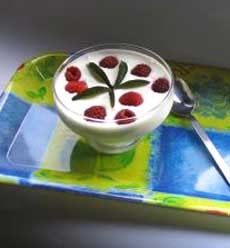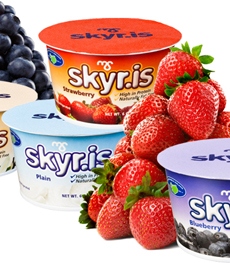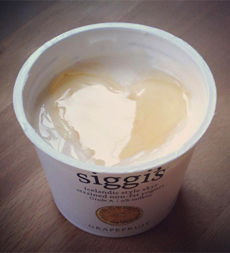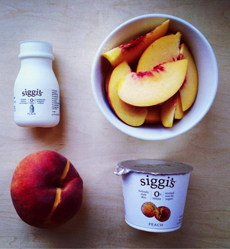
 It looks very much like yogurt, but whereas yogurt is curdled milk, skyr is actually a cheese, set with rennet. Photo by Ruben Joye | SXC. It looks very much like yogurt, but whereas yogurt is curdled milk, skyr is actually a cheese, set with rennet. Photo by Ruben Joye | SXC.
|
STEPHANIE ZONIS focuses on good foods and the people who produce them.
|
|
July 2006
Last Updated September 2012
|
 |
Skyr: Yogurt-Like Cheese From Iceland
It’s Really Cheese, Though
CAPSULE REPORT: Skyr is a cheese made by the Vikings. Most people outside of Iceland have never heard about it; those who have heard of it call it “skyr yogurt.” It resembles yogurt in texture and flavor, although technically, it’s a cheese. We’ll be seeing more of skyr as natural food chains import it and local artisans try their hand at the “new” ancient cheese in town.
Introduction To Skyr: The Viking Contribution To The Cheese World
You’re not seeing things; this article really is about a cheese produced before 900 A.D. by the Vikings, yet still available today. Skyr (pronounced “skeer”) resembles a very thick yogurt in texture; I find the consistency closest to a yogurt “cheese” I make at home, in which most of the whey is allowed to drain from the yogurt. The taste is similar to that of yogurt, though there is some difference. Skyr is not yogurt. Technically, it is cheese, made from skim milk and set with rennet.
According to several sources, dairy products figured substantially in the diet of the Vikings and were valued above most other types of foods, including meat. In Iceland itself, most of the milk came from cows until about the 1100s, when climate changes no longer permitted the keeping of large herds of cattle.
At that time, sheep became the predominant dairy animals. Grains and grain-based foods were not common in Iceland in the early medieval era and generally unobtainable there in the later medieval period, again because of a climate not conducive to their production.
Even when grains were available, they were often saved for festive occasions or used to brew ale (the Vikings were prodigious drinkers, grain-based alcoholic beverages being a way both to preserve grain and keep up one’s carbohydrate intake).
|
|

Modern skyr is made in factories as well as by artisans with a much smaller production. In Iceland, it is enjoyed as a “fast food.” Skyr not only looks like yogurt in texture, it’s packaged and flavored like it too. Have some Strawberry! Skyr.is is imported to the U.S. from Iceland. |
Contrary to the practices of many modern societies, most milk was not consumed fresh. In order to preserve it, milk was turned into butter, especially prized and capable of being stored for a very long time (the butter fermented during storage, becoming sour, and the low pH allowed for lengthy conservation) or various cheeses (such as skyr). Each batch of skyr was “inoculated” with the necessary cultures from the addition of a small amount of a previously-made batch.
Skyr & History
From everything I’ve read, skyr, by tradition, was a product low in fat. I found it strange that a traditional farmstead cheese (“farmstead” means a cheese is made from the milk of animals raised on the same farm where the cheese is produced) would be low in fat.
However, it was explained to me that the Icelandic word for skim milk is “undanrenna,” literally “running from underneath.” Milk from cows or sheep would be placed into a container and allowed to stand for a day, sometimes on ice (the separation process was dependent on the milk’s temperature; colder milk meant faster and better separation).
The next day, the milk was separated from the cream via a bowl with a hole in the bottom, out of which ran the skim milk. Milk separated in this fashion would retain a slightly higher percentage of fat than milk separated by more modern methods, but evidently skyr has been low-fat for centuries. This isn’t just a modern fad we’re talking about, after all!
|
|

Siggi’s is a brand made in New York by a man from Iceland. Photo courtesy Siggi’s. |
Lest you think that the Vikings were confined to Iceland, I must hasten to tell you that this is not the case. “Viking” is a general term that even today often has faintly negative connotations, and it’s true that the Vikings of old were raiders, who would attack towns or monasteries in search of riches, plunder, and captives. But they were also great travelers in an age when many people never ventured more than a handful of miles from their birthplace. Although the Vikings started out in Norway, Denmark, and Sweden, they expanded their territory to include (among many areas) what is now Iceland. As some of their population moved to these new settlements, their ways of life naturally followed, including a great dependence on dairy products.
Curiously, however, skyr consumption and production gradually died out in other areas once inhabited or conquered by the Vikings, and today commercial production and consumption of skyr is confined principally to Iceland, where it is viewed as a healthy “fast food.” (Some research I’ve read indicates that the skyr the Vikings ate was probably much tarter than that eaten today.)
Was skyr the strength behind the Vikings as they roamed continents and oceans? Did it account for their legendary ferocity? Probably not. But, in eating skyr, you’re consuming a little bit of history along with protein and calcium. It’s nice to recognize that some ancient foods haven’t been forgotten and can still be enjoyed centuries later, even though tastes have changed to such a great extent during the same time period.
Skyr Today
Iceland is attempting to change the limited pattern of skyr consumption by exporting it to the U.S. and other countries. However, as there are only two manufacturers of skyr in Iceland, production is somewhat limited at present.
The manufacturer with which I’m familiar is MS Iceland Dairies, located in Selfoss, Iceland. The company website can be found at SkyrIceland.com.
Today skyr has limited distribution in the U.S. Because production is small, skyr is currently sold only at Whole Foods Markets in some regions, and then only in Blueberry, Pain, Strawberry and Vanilla flavors. There are plans afoot to sell skyr in Whole Foods Markets in other regions of the country as production increases.
|
|

Skyr is made in yogurt-style cups. Also shown is a small bottle of filmjólk, traditional drinkable yogurt. Photo courtesy Siggi’s. |
Siggi Hilmarsson, a young Icelandic man in New York City, has begun an artisan skyr business and sells at leading specialty food stores in the Metropolitan New York area. He started by making it in his kitchen, and now makes it in 10 flavors. The website is Skyr.com.
If you are venturesome in the kitchen, it is possible to make skyr at home, although it is not a quick process (and Siggi comments that his attempts to make skyr at home didn’t really work because “you need a very specific temperature for the skyr to come together”). But do an online search and you’ll come up with at least several different formulations.
If you’re lucky enough to live where skyr is sold, do try some; it’s certainly become a habit of mine since I discovered it!
Thanks to Christie Ward at VikingAnswerLady.com, the Icelandic Embassy of the US, Baldvin Jonsson and Einar Matthiason.
Lifestyle Direct, Inc. All rights reserved. Images are the copyright of their respective owners. 
|





